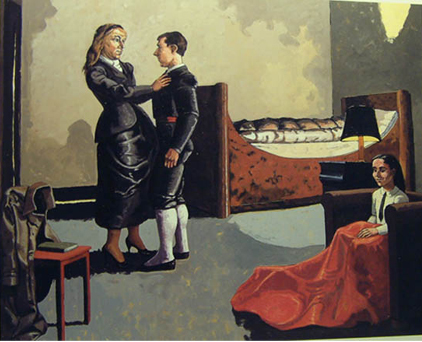THE SURREALISTS started it quite some time ago, but it is still going strong. These days, the unfa-thomable narrative painting - the picture that first looks as though it is telling a straightforward story but is, in fact, so extensively furnished with enigmatic details, with mysterious addenda to its main subject, that it does nothing of the kind - has become an independent genre. Its products are fairly easy to recognise. They usually have the air of illustrations to lost, missing or unknown texts. The situations that they depict have a mythical, archetypal character, but their iconography can never quite be pinned down. The people in them have a folklorish aura, like the subjects of fables or fairytales, but again they always elude precise identification. Acting as prompts to the imagination such paintings are, too, cryptic challenges, tests for the visual codebreaker.
The genre (pioneered by the likes of Paul Delvaux in the 1930s and 1940s) has many practitioners in this country, who could be said to include artists as diverse as Ken Kiff and Steven Campbell. The best known of them, however, may be Paula Rego. She has recently finished a one-year spell as artist-in- residence at the National Gallery, the permanent legacy of which is a somewhat indigestible three-part mural for the Sainsbury Wing's restaurant, loosely (very loosely) based on Crivelli's Annunciation: a clutch of Regoids - heavy, vaguely threatening women, or strange little girls reminiscent of Alice in Wonderland - engage in indecipherable activities in vaguely sacred settings. The rest of the paintings and studies to have resulted from her residency, grouped under the title ''Tales From the National Gallery'', are temporarily on show in the museum's Sunley Room. They demonstrate Rego's undoubted talent for dreaming up the odd, disconcerting scenario.
Initiation is a theme common to...


